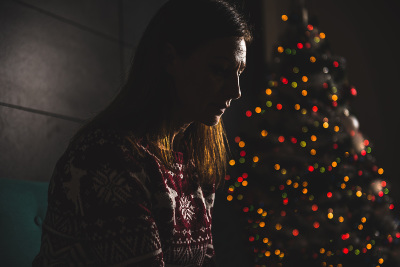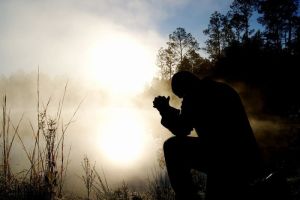Holiday blues or something else?

I left the hospital that evening, and darkness had already settled in on this mid-winter day. I ran to the car as a piercing rain had begun to fall. Chilled and wet, I glanced briefly in the rear-view mirror as I pulled away. It was going to be a long drive home in these conditions.
The long stretch of road between this small-town hospital and the highway was occasionally lit by yard lights of homes situated close to the two-lane black top. The curves were frequent and small bridges narrowed the road at unexpected times. I gripped the wheel tightly as the wiper blades matched the pounding of my heart each time, I felt the car hydroplane slightly.
“I am going to die one day on this road,” thinking of all the lives it had claimed in the few months that I had worked at this hospital. I chastised myself. “Don’t be so morbid.”
I topped a hill and immediately hit the brakes, fishtailing as I did so. I was able to pull the car to the shallow ditch to avoid hitting the car stopped in front of me. It was the first car I had seen. I understood why as I looked at the line of cars going in my direction. In the distance, I could see two overturned cars and the flashing lights of emergency vehicles. It did not look good. I backed my car to the top of the hill to prevent the accident that I had nearly missed.
“Maybe I can help.” I thought to myself. I placed my hazards on, jumped out, and ran through the rain.
I recognized one of the paramedics as I approached.
“Dr. Pyle, no survivors!,” he shouted above the noise of the rain. “You might want to turn around and access the highway on another entry, this will be awhile.”
It was December 22nd.
The remainder of drive I could not help but feel the sorrow that would be visiting the families that night. It has been a few years now since that night. I think about these families each December 22nd and wonder if the holidays are still marked with the suffering that comes from the deep darkness of grief that accompanies tragic loss.
I thought of this story as I prepared to write about the holidays and how they affect our emotions. Many families are affected by death anniversaries which fall on dates that are meant to be celebrated. This juxtaposition of joy for the season and sorrow for the loss can result in the development of complicated grief.
Other families freshly experience loss if it is the first holiday season in which their loved one is absent. Those who love or care for these families can provide comfort by being aware of dates that reflect tragedy or a celebration that is minus one for the first time.
However, despite these two unique circumstances, many others find themselves dreading the holidays or are grateful to see them in their rearview mirror. Is this merely the case of the “Holiday Blues” or a mental health disorder such as depression which can become worse during the holiday season? It is important to know the difference.
The National Alliance for Mental Illness (NAMI) reports 8% of the population are diagnosed with depression each year. Depression is a serious mental health disorder that affects the body, mood, and thoughts. A diagnosis of depression requires symptoms that have lasted longer than two weeks. Common symptoms include the following:
- Physical aches and pains
- Loss of interest or loss of pleasure in all activities
- Change in appetite or weight
- Sleep disturbances
- Feeling agitated or feeling slowed down
- Fatigue
- Feelings of low self-worth, guilt, or shortcomings
- Difficulty concentrating or making decisions
- Suicidal thoughts or intentions
A NAMI Survey reports that 64% of those suffering with mental health disorders are adversely affected by the holidays. Patients and their families can decrease or obviate these symptoms if care in foresight is achieved.
Awareness of clinical depression is the first and most important step. Seeking treatment through a multi-modal approach is crucial to managing symptoms before the holidays and during. If the patient is not already receiving care, Substance Abuse and Mental Health Administration (SAMHSA) is a good place to start.
The person suffering from depression should avoid triggers common during the holidays. These can include:
- Excess alcohol
- Sleep deprivation
- Stopping self-care
- Comparison mindset
Family and friends are important during the holidays. An interview with Cedars-Sinai psychologist, Dr. Michael Wetter, recommends the following:
- Let them know that you are there for them and that they matter to you.
- Acknowledge that the holiday season can be difficult and that it's OK not to feel happy or joyous.
- Express gratitude for having them in your life.
- Remind them that even though this might be a difficult or even painful time, things change, and they will likely feel better later.
- Most importantly, let them know that you love and care for them.
Statistically, the winter months see the lowest number of suicides. However, if you or your loved one is considering self-harm or suicide, resources are available by calling the National Suicide Prevention Hotline.
The symptoms of the “Holiday Blues” can overlap with those of depression. However, they are characterized by a shorter duration and are frequently associated with unmet expectations. Personally, I relate to this last statement. We have a large family and when gathered under one roof, our human frailties invariably reveal themselves. My “perfect” holiday becomes less than perfect. I am learning to adapt to this truth which my husband certainly appreciates.
Many factors contribute to the merry and bright being neither merry nor bright for many individuals. NAMI reports in another survey that the holidays resulted in 68% feeling financially strained, 66% experienced loneliness, 63% felt an overwhelming sense of pressure, and 55% reported happier times in past holidays compared to the present.
If you find yourself in this majority, there are steps you can take to make the end of the year as enjoyable as the beginning.
- Set realistic expectations for yourself and others.
- Evaluate your calendar and learn the art of the word, “no”.
- Limit time on social media and avoid the trap of self-comparison.
- Schedule time for self-care and downtime
- Have a budget and stick to it. In our household we went from gifts for everyone to gifts by drawing names
- Engage in outdoor activities
- Create new family traditions that are relational.
- Acknowledge your feelings to someone else.
- Volunteer as a family.
- Keep healthy habits and remember that alcohol is a depressant.
- Avoid isolation to keep from transmitting your emotions to others.
- Acknowledge your feelings to others.
- Identify ways to share the work of holiday planning.
- If you notice symptoms began before the holidays and are related to the time of year, consider evaluation by a mental health professional for diagnosis of Seasonal Affective Disorder which is treated with light box therapy.
- If symptoms persist, seek help.
This year many have lost loved ones due to the pandemic and other causes including their own, December 22nds. Grief, Complicated Grief, depression, and loneliness will be more prevalent. Care for yourself, your loved ones, and those who may be alone during this holiday season. Develop a mindset that perfection is the enemy of joyous, and commercialism is the enemy of simple, easy holidays.
The Holiday Blues are common; however, we can choose a different kind of holiday season. Let’s make merry and bright, truly merry and bright together.
Dr. Pamela Prince Pyle is a Board-Certified Internal Medicine physician who studied at Oklahoma State University, North Texas Health Science Center, and completed her training at Baylor University in Houston. She was one of three physicians selected in 1992 by Carolina Health Specialists (CHS) to begin the first hospital-based internal medicine practice outside of a university setting in the United States.




























